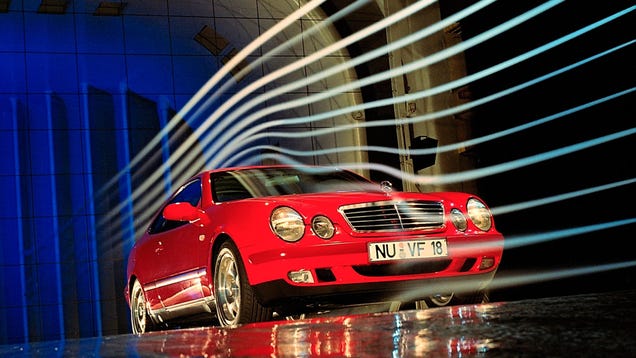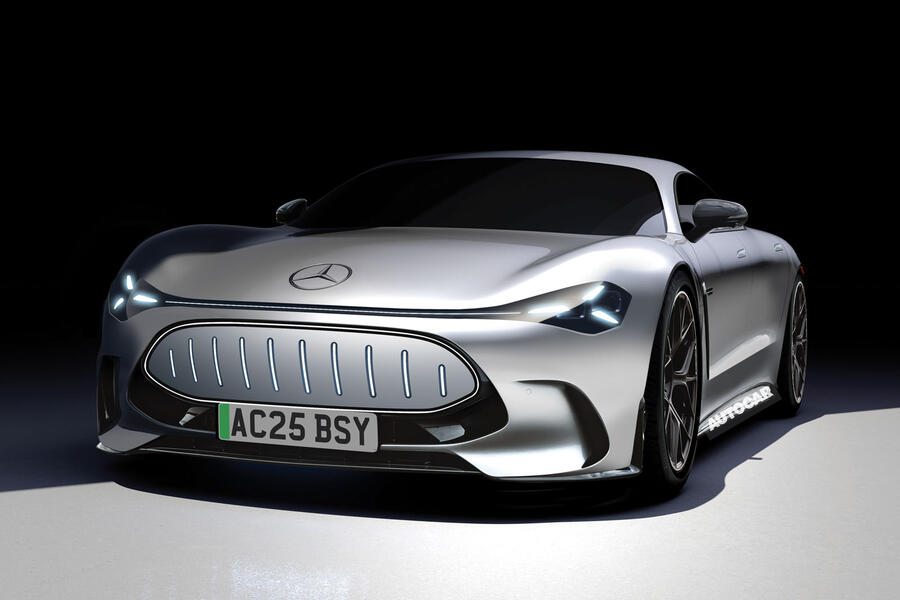Featured
Remembering Bruno Sacco: The Visionary Behind Mercedes-Benz’s Timeless Designs

The Italian design legend who helped shape Mercedes-Benz automobiles from the 1950s through the 2000s, Bruno Sacco, died last week at age 90. He helped usher in an era of iconic and stately designs which Mercedes-Benz quite clearly no longer employs. He wanted to ensure that his designs did not age, and he largely…

Mercedes-AMG’s Electric Supercar: A Bold Leap into the Future of Performance

New electric supercar is considered a key part of Mercedes-AMG's futureRetro-inspired supercar will fly the flag for AMG's battery-powered future
Mercedes-AMG is hatching plans for a spectacular electric supercar that will launch the performance brand into the EV age.
The new performance halo model was previewed by last year’s retro-inspired Vision One-Eleven concept, and it is described as a “brand-defining successor to the SLS Electric Drive”, the 730bhp quad-motor EV that was launched in 2013 and which cost £333,000. But while that car was limited to just nine examples, the new AMG supercar is planned for significantly higher production numbers when it arrives later this decade.
Making its flagship less of an exclusive offering is central to AMG’s evolving electrification strategy. It has already launched powered-up versions of the EQE, EQE SUV, EQS and EQS SUV, with specific motors and battery technology separate from those of their standard siblings.
The new electric supercar is considered a key part of Mercedes-AMG’s future, despite CEO Michael Schiebe moving to extend the life of some of AMG’s more profitable combustion-engined models amid slower than expected sales of its EVs.
However, Schiebe leaves little doubt about the company’s ultimate trajectory, telling Autocar: “It’s clear that we are going all-electric.”
The new supercar will be charged with cementing AMG’s performance credentials as it switches from high-output combustion engines to electric power. Autocar understands it is likely to outpace the 1049bhp Mercedes-AMG One, whose Formula 1-derived, V6/electric hybrid set-up is good for 0-62mph in 2.9sec and 0-186mph in 15.6sec.
Despite being tipped for higher production numbers than the SLS Electric Drive, the forthcoming supercar will be priced well above the new £160k AMG GT and is likely to take the brand into exclusive territory, competing with the Porsche Mission X and Alfa Romeo 33 supercars.
The production version of the Vision One-Eleven – itself inspired by Mercedes’ experimental C111 supercars from the 1970s – is set to use the AMG.EA architecture, which has been engineered specifically for AMG’s electric models. The platform is modular in its design, with varying lengths, wheelbases and track widths making it suitable for a wide range of models.
The upcoming production version of the Vision AMG – a four-door replacement for today’s GT 4-Door Coupé that is due to be revealed next year – will be the first new model to use it.

Like that car, the new supercar will use an 800V electric architecture and a new cylindrical-cell lithium-ion battery featuring silicon-anode developments from US battery specialist Sila.
Power will come from high-revving axial flux electric motors. To be used first in the electric GT 4-Door, they were originally developed by Yasa, before the British-based company was bought by Mercedes-Benz in 2021. Since then, the motors have been further advanced by a team of engineers from both Yasa and Mercedes-AMG.
With a highly compact disc shape that allows them to be packaged in small spaces, they are roughly half the size and half the weight of the conventional synchronous and asynchronous electric motors employed by the AMG-fettled EVs currently on sale.
Schiebe sees the axial-flux motor as a defining technical aspect of future electric AMG models, in the same way AMG’s various V8 petrol engines have been over the years.
“Customers who came to the brand because of the V8 did not come because they just wanted to have a big engine,” said Schiebe.
“They came because they loved the technology that we put into the car. So when it comes to electric driving, I’m pretty sure they will jump into that new technology because it will be the latest and greatest that you can get.”
Yasa’s axial-flux electric motors have already featured in the plug-in hybrid systems in the 986bhp Ferrari SF90 Stradale and the 1479bhp-plus Koenigsegg Regera.
Yasa officials have revealed that the patented electric motor to be used by AMG offers more than twice the power of Yasa’s existing electric motors on a power-to-weight basis: up to 489bhp and 590lb ft, with a weight of just 24kg.
They also revealed that a number of different drivetrain layouts have been developed, including a single- front and twin-motor rear set-up as well as a quad-motor arrangement with two front and two rear units. Depending on the layout, this confirms the next generation of electric AMG models will have a significant increase in power and performance over that of those models on sale today.
Production of AMG’s axial-flux motors will take place at Mercedes’ Berlin-Marienfelde plant, starting next year. However, Schiebe said AMG will not abandon its ‘one man, one engine’ philosophy, adding: “This is part of our DNA. We will have something in the future which is comparable to ‘one man, one engine’, and it will not be just a marketing effort.”
Hurricane Helene’s Aftermath: A Global Automotive Industry in Turmoil

Hurricane Helene left a trail of death and destruction throughout the U.S. Southeast, but the impact of the massive storm may disrupt the automotive industry worldwide for months to come.

Elevating Luxury: The New Bentley Continental GT Speed Redefines Performance and Efficiency
 New, more potent V8 hybrid powertrain adds efficiency and performance; new air suspension brings extra poise
More than anything, the new Bentley Continental GT Speed represents a bold extension of the Crewe company’s abiding philosophy. For the past 40 years, ever since the high-performing Turbo R single-handedly revived a moribund Bentley marque, the firm has specialised in offering cars that seem far too refined and luxurious for their supercar performance. Or viewed another way, cars that seem too practical for their exalted position in the automotive firmament.These capabilities were especially well expressed in the groundbreaking Continental GT of 2003, a car whose dynamics at the time easily equalled those of far less usable front-engined Astons and Ferraris. They were further emphasised when the third-generation 2019 GT adopted the Volkswagen Group's MSB platform (shared with Porsche), which enabled bigger wheels and brakes, lots of extra technology and a reduced front overhang for even better weight distribution.Now it’s time for the fourth-generation car, officially called Continental GT Speed, to widen this virtuous spectrum even further. Central to the new offering is a brand-new plug-in hybrid powertrain, comprising a new 584bhp 4.0-litre V8 engine and a 187bhp electric motor that’s buried inside the engine’s eight-speed dual-clutch gearbox. The car also gets an even more ideal weight distribution, and a new system of two-mode air springs and dual-valve dampers that bring extra versatility to the three main driving modes (Sport, Comfort and Bentley).
New, more potent V8 hybrid powertrain adds efficiency and performance; new air suspension brings extra poise
More than anything, the new Bentley Continental GT Speed represents a bold extension of the Crewe company’s abiding philosophy. For the past 40 years, ever since the high-performing Turbo R single-handedly revived a moribund Bentley marque, the firm has specialised in offering cars that seem far too refined and luxurious for their supercar performance. Or viewed another way, cars that seem too practical for their exalted position in the automotive firmament.These capabilities were especially well expressed in the groundbreaking Continental GT of 2003, a car whose dynamics at the time easily equalled those of far less usable front-engined Astons and Ferraris. They were further emphasised when the third-generation 2019 GT adopted the Volkswagen Group's MSB platform (shared with Porsche), which enabled bigger wheels and brakes, lots of extra technology and a reduced front overhang for even better weight distribution.Now it’s time for the fourth-generation car, officially called Continental GT Speed, to widen this virtuous spectrum even further. Central to the new offering is a brand-new plug-in hybrid powertrain, comprising a new 584bhp 4.0-litre V8 engine and a 187bhp electric motor that’s buried inside the engine’s eight-speed dual-clutch gearbox. The car also gets an even more ideal weight distribution, and a new system of two-mode air springs and dual-valve dampers that bring extra versatility to the three main driving modes (Sport, Comfort and Bentley).Hurricane Aftermath: The Hidden Danger of Electric Vehicle Fires
Electric vehicle fires have made headlines for years now, but in the aftermath of Hurricane Helene, the Category 4 hurricane that caused record devastation from wind, rain, and storm surge, EVs are spontaneously combusting and saltwater is a main culprit. Florida Gov. Ron DeSantis urged EV owners to get their vehicles…

